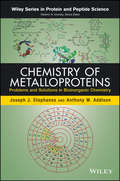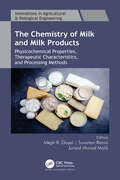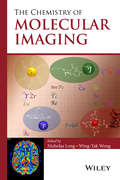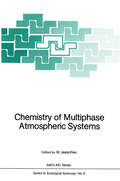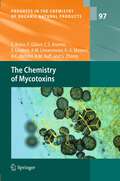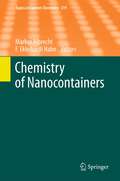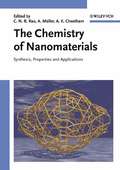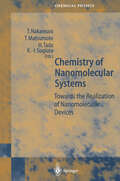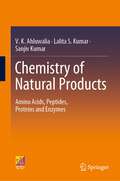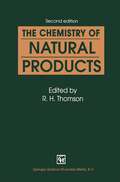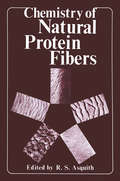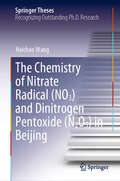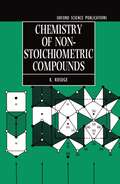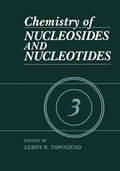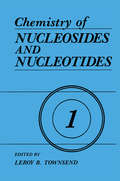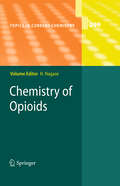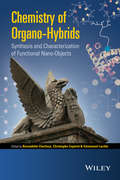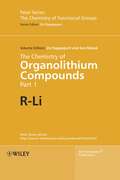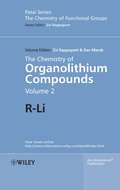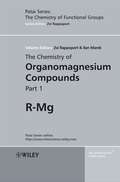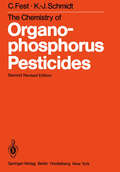- Table View
- List View
Chemistry of Metalloproteins: Problems and Solutions in Bioinorganic Chemistry (Wiley Series in Protein and Peptide Science)
by Joseph J. Stephanos Anthony W. AddisonAddresses the full gamut of questions in metalloprotein science Formatted as a question-and-answer guide, this book examines all major families of metal binding proteins, presenting our most current understanding of their structural, physicochemical, and functional properties. Moreover, it introduces new and emerging medical applications of metalloproteins. Readers will discover both the underlying chemistry and biology of this important area of research in bioinorganic chemistry. Chemistry of Metalloproteins features a building block approach that enables readers to master the basics and then advance to more sophisticated topics. The book begins with a general introduction to bioinorganic chemistry and metalloproteins. Next, it covers: Alkali and alkaline earth cations Metalloenzymes Copper proteins Iron proteins Vitamin B12 Chlorophyll Chapters are richly illustrated to help readers fully grasp all the chemical concepts that govern the biological action of metalloproteins. In addition, each chapter ends with a list of suggested original research articles and reviews for further investigation of individual topics. Presenting our most current understanding of metalloproteins, Chemistry of Metalloproteins is recommended for students and researchers in coordination chemistry, biology, and medicine. Each volume of the Wiley Series in Protein and Peptide Science addresses a specific facet of the field, reviewing the latest findings and presenting a broad range of perspectives. The volumes in this series constitute essential reading for biochemists, biophysicists, molecular biologists, geneticists, cell biologists, and physiologists as well as researchers in drug design and development, proteomics, and molecular medicine with an interest in proteins and peptides.
The Chemistry of Milk and Milk Products: Physicochemical Properties, Therapeutic Characteristics, and Processing Methods (Innovations in Agricultural & Biological Engineering)
by Megh R. Goyal Suvartan Ranvir Junaid Ahmad MalikMilk and milk products are highly nutritious, yet their low acidity provides a favorable environment for growth of pathogenic and spoilage-causing organisms. To avoid this, milk requires specialized processes to be converted into various milk products to ensure safety and quality. This new volume provides an understanding of the manufacturing processes of milk products and the structural, physicochemical, and compositional changes that occur during manufacturing and storage of milk products and the impact on quality. It covers methods of conversion of milk into high-value, concentrated, extended shelf-life and easily transportable dairy products. It delves into the constituents and chemistry, physicochemical properties, and therapeutic characteristics of milk and milk products, and then goes on to present specialized processing methods. Specialized methods such as proteolysis in ultra-high temperature (UHT), heat and acid coagulation of milk products, processing and characteristics of dry dairy milk powders, and methods to monitor pesticide residues in milk and milk products are presented and evaluated.
The Chemistry of Milk and Milk Products: Physicochemical Properties, Therapeutic Characteristics, and Processing Methods (Innovations in Agricultural & Biological Engineering)
by Megh R. Goyal Suvartan Ranvir Junaid Ahmad MalikMilk and milk products are highly nutritious, yet their low acidity provides a favorable environment for growth of pathogenic and spoilage-causing organisms. To avoid this, milk requires specialized processes to be converted into various milk products to ensure safety and quality. This new volume provides an understanding of the manufacturing processes of milk products and the structural, physicochemical, and compositional changes that occur during manufacturing and storage of milk products and the impact on quality. It covers methods of conversion of milk into high-value, concentrated, extended shelf-life and easily transportable dairy products. It delves into the constituents and chemistry, physicochemical properties, and therapeutic characteristics of milk and milk products, and then goes on to present specialized processing methods. Specialized methods such as proteolysis in ultra-high temperature (UHT), heat and acid coagulation of milk products, processing and characteristics of dry dairy milk powders, and methods to monitor pesticide residues in milk and milk products are presented and evaluated.
The Chemistry of Molecular Imaging
by Nicholas Long Wing-Tak WongMolecular imaging is primarily about the chemistry of novel biological probes, yet the vast majority of practitioners are not chemists or biochemists. This is the first book, written from a chemist's point of view, to address the nature of the chemical interaction between probe and environment to help elucidate biochemical detail instead of bulk anatomy. Covers all of the fundamentals of modern imaging methodologies, including their techniques and application within medicine and industry Focuses primarily on the chemistry of probes and imaging agents, and chemical methodology for labelling and bioconjugation First book to investigate the chemistry of molecular imaging Aimed at students as well as researchers involved in the area of molecular imaging
The Chemistry of Molecular Imaging
by Nicholas Long Wing-Tak WongMolecular imaging is primarily about the chemistry of novel biological probes, yet the vast majority of practitioners are not chemists or biochemists. This is the first book, written from a chemist's point of view, to address the nature of the chemical interaction between probe and environment to help elucidate biochemical detail instead of bulk anatomy. Covers all of the fundamentals of modern imaging methodologies, including their techniques and application within medicine and industry Focuses primarily on the chemistry of probes and imaging agents, and chemical methodology for labelling and bioconjugation First book to investigate the chemistry of molecular imaging Aimed at students as well as researchers involved in the area of molecular imaging
The Chemistry of Mood, Motivation, and Memory: The proceedings of an interdisciplinary conference on the Chemistry of Mood, Motivation, and Memory held at the University of California, San Francisco, in October 1971 (Advances in Behavioral Biology #4)
by James L. McGaughThis volume is based on presentations at an interdisciplinary conference on The Chemistry of Mood, Motivation and Memory which was held at the University of California, San Francisco in October, 1971. The conference was sponsored and supported by the Division of Continuing Education in Health Sciences. We thank Dr. Ruben Dixon and his staff for help in planning the conference and for attending to all of the organizational details. We particularly thank the participants for their contributions to the conference and for their cooperation in preparing the manu scripts based on their conference presentations. All of the details involved in preparing the volume for publi cation were handled by Karen Dodd. We are grateful to her for her tireless, efficient and productive efforts. We hope that this volume will help to stimulate further interest as well as understanding of the biochemical bases of our behavior. James L. McGaugh v CONTRIBUTORS Bernard W. Agranoff, Ph.D. Department of Psychiatry Mental Health Research Institute The University of Michigan Ann Arbor, Michigan Samuel H. Barondes, M.D. Professor of Psychiatry School of Medicine University of California at San Diego La Jolla, California Barry D. Berger, Ph.D. Wyeth Laboratories Philadelphia, Pennsylvania Enoch Callaway, M.D. Professor of Psychiatry University of California School of Medicine San Francisco, California J. Anthony Deutsch, Ph.D. Professor of Psychology University of California at San Diego La Jolla, California Edward Glassman, Ph.D.
Chemistry of Multiphase Atmospheric Systems (Nato ASI Subseries G: #6)
by WolfgangJaeschkeRapidly increasing interest in the problems of air pollution and source-receptor relationships has led to a significant expansion of knowledge in the field of atmospheric chemistry. In general the chemistry of atmospheric trace constituents is governed by the oxygen content of the atmosphere. Upon entering the atmosphere in a more or less reduced state, trace substances are oxidized via various pathways and the generated products are often precursors of acidic compounds. Beside oxidation processes occurring in the gas phase, gaseous compounds are often converted into solid aerosol particles. The various steps within gas-to-particle conversion are constantly interacting with condensation processes, which are caused by the tropospheric water content. Thus in addition to the gaseous state, a liquid and solid state exists within the troposphere. The solid phase consists of atmospheric conversion products or fly ash and mineral dust. The liquid phase consists of water, conversion products and soluble compounds. The chemistry occurring within this system is often referred to as hydrogeneous chemistry. The chemist interprets this term, however, more strictly as reactions which occur only at an interphase between phases. This, however, is not always what happens in the atmosphere. There are indeed heterogeneous processes such as reactions occurring on the surface of dry aerosol particles. But apart from these, we must focus as well on reactions in the homogeneous phase, which are single steps of consecutive reactions running through various phases.
The Chemistry of Mycotoxins (Progress in the Chemistry of Organic Natural Products #97)
by Stefan Bräse Franziska Gläser Carsten Kramer Stephanie Lindner Anna M. Linsenmeier Kye-Simeon Masters Anne C. Meister Bettina M. Ruff Sabilla ZhongThe biological activity of mycotoxins ranges from weak and/or sometimes positive effects, such as antibacterial activity (see penicillin derivatives derived from Penicillium strains) to strong mutagenic (e. g. aflatoxins, patulin), carcinogenic (e. g. aflatoxins), teratogenic, neurotoxic (e. g. ochratoxins), nephrotoxic (e. g. fumonisins, citrinin), hepatotoxic, and immunotoxic (e. g. ochratoxins, diketopiperazines) activity. Nowadays, many laboratories around the world are specialized in the detection of mycotoxins in food products and contaminated material found in housing. In this volume, a focus on the most important classes of mycotoxins is provided and their chemistry of the last ten years is discussed. In each Section, the individual biological impact is outlined. Sections are arranged according to mycotoxin classes (e. g. aflatoxins) and/or structural classes (e. g. resorcinyl lactones, diketopiperazines). The biology of mycotoxins is also described.
Chemistry of Nanocontainers (Topics in Current Chemistry #319)
by Markus Albrecht and Ekkehardt HahnMolecular Cages and Capsules with Functionalized Inner Surfaces, by Stefan Kubik. Drug Delivery by Water-Soluble Organ metallic Cages, by Bruno Therrien. Reversibly Expanded Encapsulation Complexes, by Dariush Ajami und Julius Rebek. Container Molecules Based on Imine Type Ligands, by A. Carina Schulze und Iris M. Oppel. Molecular Capsules Derived from Resorcin[4]arenes by Metal-Coordination, by Tobias Schröder, Satya Narayan Sahu und Jochen Mattay. Coronates, Spherical Containers, Bowl-Shaped Surfaces, Porous 1D-, 2D-, 3D-Metallo-Coordination Polymers, and Metallodendrimers, by Rolf W. Saalfrank und Andreas Scheurer.
The Chemistry of Nanomaterials: Synthesis, Properties and Applications
by C. N. R. Rao Achim Müller Anthony K. CheethamWith this handbook the distinguished team of editors has combined the expertise of leading nanomaterials scientists to provide the latest overview of this field. The authors cover the whole spectrum of nanomaterials, ranging from theory, synthesis, properties, characterization to application, including such new developments as: quantum dots, nanoparticles, nanoporous materials, as well as nanowires, nanotubes and nanostructural polymers nanocatalysis, nanolithography, nanomanipulation methods for the synthesis of nanoparticles. The book can thus be recommended for everybody working in nanoscience: Beginners can acquaint themselves with the exciting subject, while specialists will find answers to all their questions plus helpful suggestions for further research.
Chemistry of Nanomolecular Systems: Towards the Realization of Molecular Devices (Springer Series in Chemical Physics #70)
by Takayoshi Nakamura Takuya Matsumoto Hirokazu Tada Ken-Ichi SugiuraRecently, molecular electronics, especially that utilizing single molecules, has been attracting much attention. This is mainly because the theoretical limit is approaching in the present silicon-based technology, and the development of an alternative process is strongly desired. Single-molecule electronics is aimed at a breakthrough toward the next generation of computing systems. By designing and synthesizing highly functionalized molecules of nanometer size and incorporating these molecules into electrical circuits, we shall obtain much dense and high-speed processors. The concept of single-molecule electronics was first introduced by Aviram and Ratnar in 1978. In the early 1980s, many groups all over the world had started research on molecular electronics. At that time, single-molecule manipulation techniques had not been born, and the research was mainly carried out on molecular films formed by the Langmuir~Blodgett technique, a wet process, and by molecular-beam epitaxy, a dry process. A number of prototypes of switching devices and logic gates were, however, reported in the 1980s. In the early 1990s, scanning probe microscopes became popular and researchers obtained a single-molecule manipulation and evaluation tech nique. It became possible to fabricate practical devices using single molecules or small numbers of molecules. Finally, at the end of the last century, an explosion in the research field of single-molecule electronics was witnessed. In addition, studies of "biocomputing" started in the early 1980s and significant progress was achieved in the last century.
Chemistry of Natural Products: Amino Acids, Peptides, Proteins and Enzymes
by V.K. Ahluwalia Lalita S. Kumar Sanjiv KumarThis book is designed to serve as a textbook for core as well as elective courses offered to undergraduate and advanced undergraduate students enrolled in chemistry. This textbook comprehensively deals various topics of organic chemistry such as amino acids, peptides, proteins and enzymes. The text is divided into four chapters: a chapter each dedicated to amino acids, peptides, proteins and enzymes, respectively. The important reactions have been explained with the help of the mechanisms involved. It gives a detailed account of the solution phase and solid phase synthesis of peptides as well as discussing the structure and function of some biologically important peptides. It also covers the classification, nomenclature and mode of action of enzymes, and a detailed account of the structure and function of different co-enzymes. The book also includes pedagogical features like end-of-chapter exercises to aid in self learning. Given the scope, this textbook will be useful for graduate and advanced graduate students pursuing the course of chemistry, especially organic chemistry.
Chemistry of Natural Protein Fibers
by R. S. AsquithThis volume arose originally from the complaints of the editor's students, both undergraduate and postgraduate, that there was no modern book on protein fibers which told enough about protein science and chemical tech nologies related to fibers. By and large this is probably a reasonable cri de coeur. The undergraduate on a technological course, lacking information on the basic scientific techniques used to carry out the research on which his fiber technology is based, can find it difficult to obtain this information. The pure science undergraduate often lacks knowledge of the application of these techniques in protein fiber technology. The young graduates, com mencing research related to some aspect of protein fibers, are drawn from a wide range of scientific disciplines, having been trained as biochemists, chemists, physicists, technologists, and histologists, to name but a few. Generally these new research workers pass through a preliminary "lost" period in which they have to evaluate their background in relation to the wide and differing fields of research in protein fiber science to which they are now exposed. As time goes on they then either develop a wide knowledge covering science and technology or remain in a specific part of their original discipline, with a narrow knowledge of its application in the field of the research degree they are taking.
The Chemistry of Nitrate Radical (Springer Theses)
by Haichao WangThis book systematically describes the instrument setup for the measurement of nitrate radical (NO3) and dinitrogen pentoxide (N2O5), as well as the mixing ratio, chemical behaviors, and atmospheric impacts of NO3 and N2O5 in Beijing, China. It also discusses the instrument design and data analysis method in detail. Based on several field measurements of NO3 and N2O5 in Beijing, it shows the variation in concentration and the budget of NO3 and N2O5. The N2O5 heterogeneous uptake coefficient was determined using various methods, and the relationship between the N2O5 uptake coefficient and the particle properties was demonstrated, as well as the impact of NO3–N2O5 chemistry to the atmospheric oxidation and the formation of particulate nitrate. These results increase our understanding of nighttime chemistry and provide insights into the role of NO3–N2O5 chemistry in other polluted regions.
Chemistry of Non-stoichiometric Compounds
by Koji KosugeThis unified presentation of the chemistry of non-stoichiometric compounds is the first monograph on the subject for two decades. Based on statistical thermodynamics and structural inorganic chemistry, with descriptions of modern examples and applications, this will be useful to both researchers in industry and undergraduates in solid state chemistry and physics.
Chemistry of Nucleosides and Nucleotides: Volume 1
by L. B. TownsendThe present volume is the first of a projected four-volume treatise. This volume contains the following chapters: "Synthesis and Reaction of Pyrimidine Nucleosides," "Synthesis and Properties of Purine Nucleosides and Nucleotides," and "Synthesis and Properties of Oligonucleotides." These three chapters were selected for inclusion in Volume I because the areas have provided the basis and impetus for the initiation and development of the other areas of research, which will be described in subsequent volumes. Each chapter is rather comprehensive in nature and should provide a ready reference source for not only the novice but also the experienced investigator or researcher. The chapters have been prepared by authors with considerable experience in each particular area of research, and this has resulted in a lucid presentation of each well-defined area. These volumes were designed with medicinal chemists, medicinal organic chemists, organic chemists, carbohydrate chemists, physical chemists, and biological chemists in mind. However, because of the tremendous recent interest in this research area owing to the biological and chemotherapeutic evaluation of nucleosides and nucleotides as anticancer, antiviral, and antiparasitic agents, these volumes should also be valuable additions to the libraries of virologists, biochemical pharmacologists, oncologists, and pharmacologists. We would like to thank the authors for their enthusiasm and help in making these volumes available to the scientific community.
Chemistry of Opioids (Topics in Current Chemistry #299)
by Hiroshi NagaseRecent Advances in the Synthesis of Morphine and Related Alkaloids; by N. Chida * Opioids in Preclinical and Clinical Trials; by H. Nagase and H. Fujii * Synthesis of 14-Alkoxymorphinan Derivatives and Their Pharmacological Actions; by H. Schmidhammer and M. Spetea * 14-Amino-4,5-Epoxymorphinan Derivatives and Their Pharmacological Actions; by J. W. Lewis and S. M. Husbands * Nonpeptidic Delta (δ) Opioid Agonists and Antagonists of the Diarylmethylpiperazine Class: What Have We Learned?; by S. N. Calderon * Synthesis of Neoclerodane Diterpenes and Their Pharmacological Effects; by K. M. Lovell, K. M. Prevatt-Smith, A. Lozama and T. E. Prisinzano * Synthesis of Novel Basic Skeletons Derived from Naltrexone; by H. Nagase and H. Fujii * Twin and Triplet Drugs in Opioid Research; by H. Fujii * 3D-Pharmacophore Identification for κ-Opioid Agonists Using Ligand-Based Drug-Design Techniques; by N. Yamaotsu and S. Hirono
Chemistry of Organo-hybrids: Synthesis and Characterization of Functional Nano-Objects
by Bernadette Charleux Christophe Coperet Emmanuel LacoteThis book provides readers with a one-stop entry into the chemistry of varied hybrids and applications, from a molecular synthetic standpoint • Describes introduction and effect of organic structures on specific support components (carbon-based materials, proteins, metals, and polymers). • Chapters cover hot topics including nanodiamonds, nanocrystals, metal-organic frameworks, peptide bioconjugates, and chemoselective protein modification • Describes analytical techniques, with pros and cons, to validate synthetic strategies • Edited by internationally-recognized chemists from different backgrounds (synthetic polymer chemistry, inorganic surfaces and particles, and synthetic organic chemistry) to pull together diverse perspectives and approaches
Chemistry of Organo-hybrids: Synthesis and Characterization of Functional Nano-Objects
by Bernadette Charleux Christophe Coperet Emmanuel LacoteThis book provides readers with a one-stop entry into the chemistry of varied hybrids and applications, from a molecular synthetic standpoint • Describes introduction and effect of organic structures on specific support components (carbon-based materials, proteins, metals, and polymers). • Chapters cover hot topics including nanodiamonds, nanocrystals, metal-organic frameworks, peptide bioconjugates, and chemoselective protein modification • Describes analytical techniques, with pros and cons, to validate synthetic strategies • Edited by internationally-recognized chemists from different backgrounds (synthetic polymer chemistry, inorganic surfaces and particles, and synthetic organic chemistry) to pull together diverse perspectives and approaches
The Chemistry of Organolithium Compounds (Patai's Chemistry of Functional Groups)
by Zvi Rappoport Ilan MarekThis is the first volume in the series to concentrate on organo-lithium compounds - the sub series "The chemistry of the metal-carbon bond" (5 vol) treated organometallics in general. It deals with theoretical/physical/computational apsects, as well as major spectroscopies, such as MS, NMR, IR/UV etc and both biological and industrial applications. * The core of the volume is the synthetic chapters with lots of examples for modern synthetic approaches * Written by key researchers in the field * An invaluable reference source to organic chemists working in academia and industry * Features important reagents in organic synthesis
The Chemistry of Organolithium Compounds: R-Li (Patai's Chemistry of Functional Groups)
by Zvi Rappoport Ilan MarekPatai Series: The Chemistry of Functional Groups A series of advanced treatises founded by Professor Saul Patai and under the general editorship of Professor Zvi Rappoport The Patai Series publishes comprehensive reviews on all aspects of specific functional groups. Each volume contains outstanding surveys on theoretical and computational aspects, NMR, MS, other spectroscopical methods and analytical chemistry, structural aspects, thermochemistry, photochemistry, synthetic approaches and strategies, synthetic uses and applications in chemical and pharmaceutical industries, biological, biochemical and environmental aspects. To date, over 100 volumes have been published in the series. Recently Published Titles The chemistry of the Cyclopropyl Group (Volume 2) The chemistry of the Hydrazo Azo and Azozy Groups (Volume 2, 2 parts) The chemistry of Double-Bonded Functional Groups (Volume 3, 2 parts) The chemistry of Organophosphorus Compounds (Volume 4) The chemistry of Halides, Pseudo-Halides and Azides (Volume 2, 2 parts) The chemistry of the Amino, Nitro and Nitroso Groups (2 volumes, 2 parts) The chemistry of Dienes and Polyenes (2 volumes) The chemistry of Organic Derivatives of Gold and Silver The chemistry of Organic Silicon Compounds (2 volumes, 4 parts) The chemistry of Organic Germanium, Tin and Lead Compounds (Volume 2, 2 parts) The chemistry of Phenols (2 parts) The chemistry of Organolithium Compounds (2 parts) The chemistry of Cyclobutanes (2 parts) Forthcoming Titles The chemistry of Peroxides (Volume 2, 2 parts) The chemistry of Organozinc Compounds The chemistry of Anilines The Patai Series Online The Patai Series is available in electronic format on Wiley InterScience. All new titles will be published online and a growing list of older titles is added every year. It is the ultimate goal that all titles published in the Patai Series will be available in electronic format.
The Chemistry of Organomagnesium Compounds, 2 Volume Set (Patai's Chemistry of Functional Groups #173)
by Zvi Rappoport Ilan MarekMagnesium remains almost unique among the metals in its ability to react directly with a wide variety of compounds. This organic chemistry field has seen steady progress, and a volume on this topic is long overdue. In the tradition of the Patai Series this title treats all aspects of functional groups, containing chapters on the theoretical and computational foundations; on analytical and spectroscopic aspects with dedicated chapters on Mass Spectrometry, NMR, IR/UV, etc.; on reaction mechanisms; on applications in syntheses. Depending on the functional group there are also chapters on industrial use, on effects in biological and/or environmental systems. Since the area of Organomagnesium Chemistry continues to grow far beyond the classical Grignard Reagents, this is an essential resource to help the reader keep abreast of the latest developments.
The Chemistry of Organophosphorus Pesticides
by C. Fest K.-J. SchmidtRapid progress in the field of organophosphate compounds has made this new edition necessary. Particular attention has been paid to new developments in biologically active products as this is probably of greatest interest to practical chemists. I have therefore updated the chapter on chemistry and, in connection with this, rewritten the chapter on metabolism. I should especially like to thank Professor Dr. HELLMUT HOFFMANN for his constant encouragement and interest in my work and for many fruitful discus sions. The co-author to the 1st edition, Dr. KARL-JULIUS SCHMIDT, died suddenly on November 21, 1980. I treasure the memory of a valued colleague of many years standing. Elberfeld, January 1982 CHRISTA FEST VII Preface to the First Edition Our intention has been to provide a short introduction to the chemistry and mode of action of insecticidal phosphoric acid compounds, with particular ref erence to the relationship between structure and activity. The yearly produc tion of these pesticides is now approaching 100,000 tons and thus offers an im portant example of applied research. If, however, one examines the historical development of these compounds, it is apparent that this was preceded by a hundred years of pure chemistry of phosphorus.
